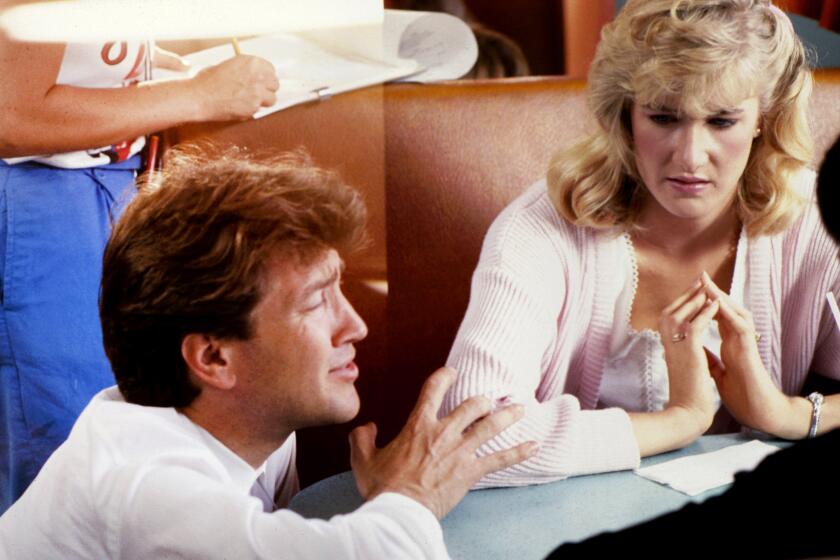With Oscar Nominations, Narrative Beats Explosions
- Share via
Like Supreme Court Justice Potter Stewart, who famously said of obscenity, “I know it when I see it,” the Academy of Motion Picture Arts and Sciences recognizes the real thing, even in disguise.
While Oscar nominations used to be reserved exclusively for major Hollywood studio releases, this year almost the exact opposite was true. In fact, the point could be made that all five of the best picture choices (which also happen to be the five with the most nominations, 45 among them), are independent films after a fashion. “Shakespeare in Love,” “Life Is Beautiful” and “Elizabeth” were distributed by indie powerhouses Miramax Films and Gramercy Pictures, and the other two, Steven Spielberg’s “Saving Private Ryan” and Terrence Malick’s “The Thin Red Line,” were so completely free from studio influence and/or interference as to be independent in everything but name.
What this means for moviegoers in regions where Hollywood has a stranglehold on exhibition is that a large number of feature films with multiple Oscar nominations, such as “Hilary and Jackie,” “Central Station,” “Gods and Monsters” and “Affliction,” in addition to “Life Is Beautiful” and “Elizabeth,” will probably be completely unfamiliar.
But it’s not the academy that has changed, it’s the movie business. Although “Armageddon” managed a quartet of less prestigious nominations, and even “Patch Adams” got a nod for original musical or comedy score, by and large the studios have taken themselves out of the Oscar business. The kind of gargantuan “tent pole” movies that the majors prefer to turn out may set records at multiplexes, but they don’t offer the satisfactions that the industry is willing to take pride in at awards time.
What voters go for instead of Hollywood behemoths are the kinds of films that the academy has liked for time out of mind: stories in which involving characters outnumber skyrocketing explosions, in which narrative matters more than a hot soundtrack or barely legal stars. Abandoned by the grosses-crazed studios, voters now have to seek out independently made films to slake that particular thirst. The star names may be unfamiliar to casual moviegoers, but if they were to take the time to sample the nominated films, they’d feel right at home in terms of content and style.
Making that point even stronger is the list of independent films favored by critics organizations that the academy pointedly ignored: “Rushmore” and its splendid performance by Bill Murray (more about that later), “Happiness,” “High Art,” “The General,” “The Opposite of Sex.” Offbeat, edgy, difficult to digest, they are not to the academy’s taste (or many other people’s, for that matter) and were fated from the start to be bypassed by voters even in this indie-friendly age.
One of the unfortunate byproducts of this yearning for old-fashioned satisfactions is the extension this year to the foreign language committee. Three of the year’s most exciting and innovative foreign films--the Danish “Celebration,” the German “Run Lola Run” and the marvelous French “The Dream Life of Angels,” each a major critical and box-office success in its own country--were clearly too adventurous for this middle-of-the-road group.
In addition to knowing what it likes and seeking it out, the academy knows what it dislikes and feels free to ignore--including, year after year, films that it views strictly as comedies and thus, almost by definition, not worthy of serious consideration. This not only hurt Murray’s remarkable performance in “Rushmore,” but it also was a factor in the relatively poor showing (three nominations, but no acting nod for star Jim Carrey) for one of the pre-voting favorites, “The Truman Show.” Overly long, self-consciously serious films like “The Thin Red Line” (seven nominations) have a much easier time with this group.
In retrospect, several other factors hurt “Truman” as well. Academy voters tend to react badly when other people tell them what’s of lasting value, and the campaign trumpeting Esquire magazine film critic David Thomson’s rapturous quote about the film, though it initially captured everyone’s attention and helped at the box office, may have eventually backfired with the academy.
There is also the academy’s much commented upon limited attention span. Aside from “Saving Private Ryan,” a film very hard to forget, all four other best picture nominees had late fall/early winter opening dates, ranging from Oct. 23 for “Life Is Beautiful” through Dec. 23 for “The Thin Red Line.” By contrast, “The Truman Show,” which opened June 5, a full six weeks before “Private Ryan,” may have been too distant a memory when voting time came around.
Benefiting most from being the new fun kid on the block was “Shakespeare in Love,” whose 13 nominations no doubt reflected, in part, the academy’s infatuation with a spanking new film (release date Dec. 11) whose satisfactions were completely unexpected.
With “Shakespeare in Love” and “Private Ryan” firmly established as the two front-runners for the best picture Oscar, the question now is whether “Shakespeare” can retain its gamin-like freshness or whether the more substantial accomplishments of “Ryan” will be able to reestablish their presence.
(BEGIN TEXT OF INFOBOX / INFOGRAPHIC)
And the Nominees Are...
BEST PICTURE
Elizabeth
Life Is Beautiful
Saving Private Ryan
Shakespeare in Love
The Thin Red Line
****
BEST ACTRESS
Cate Blanchett--Elizabeth
Fernanda Montenegro--Central Station
Gwyneth Paltrow--Shakespeare in Love
Meryl Streep--One True Thing
Emily Watson--Hilary and Jackie
****
BEST ACTOR
Roberto Benigni--Life Is Beautiful
Tom Hanks--Saving Private Ryan
Ian McKellen--Gods and Monsters
Nick Nolte--Affliction
Edward Norton--American History X
* For a complete list of nominees and more Oscar-related stories, see F1.
More to Read
Only good movies
Get the Indie Focus newsletter, Mark Olsen's weekly guide to the world of cinema.
You may occasionally receive promotional content from the Los Angeles Times.











